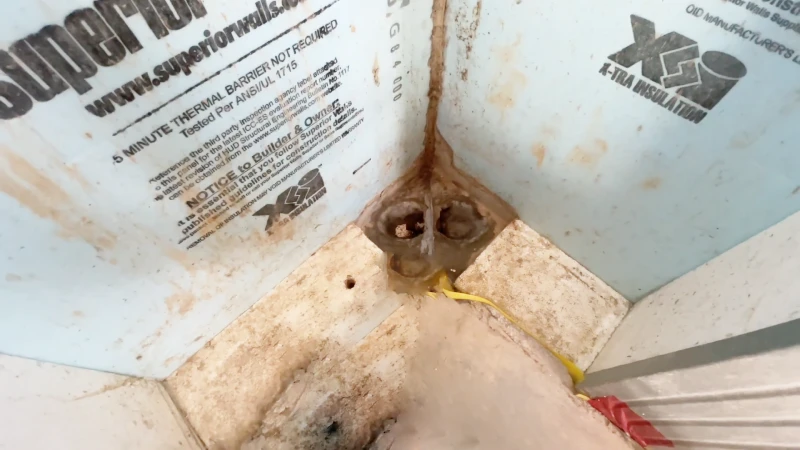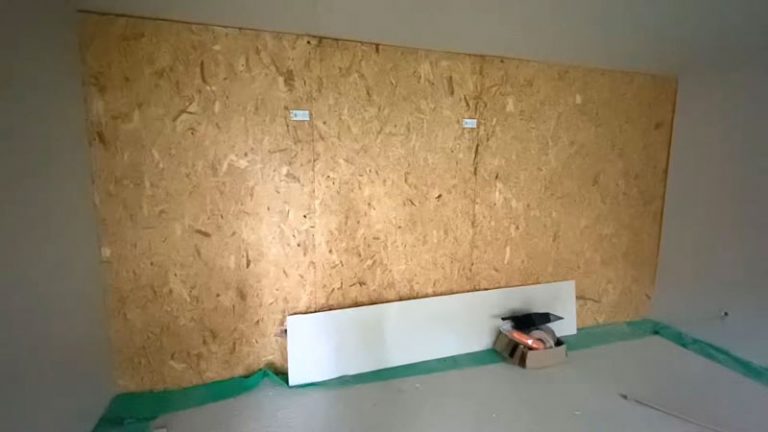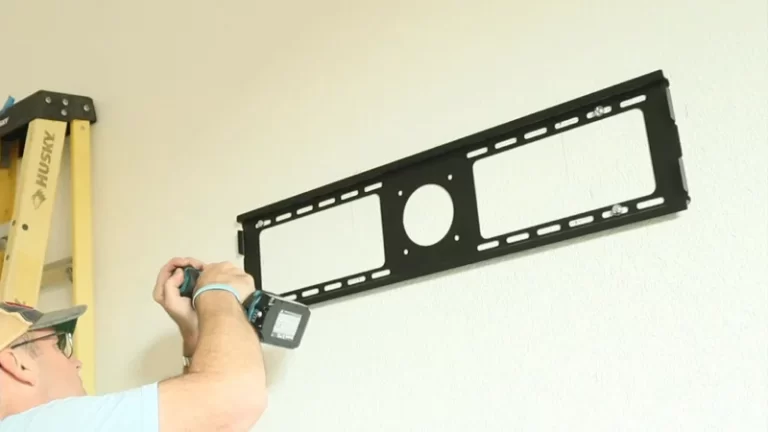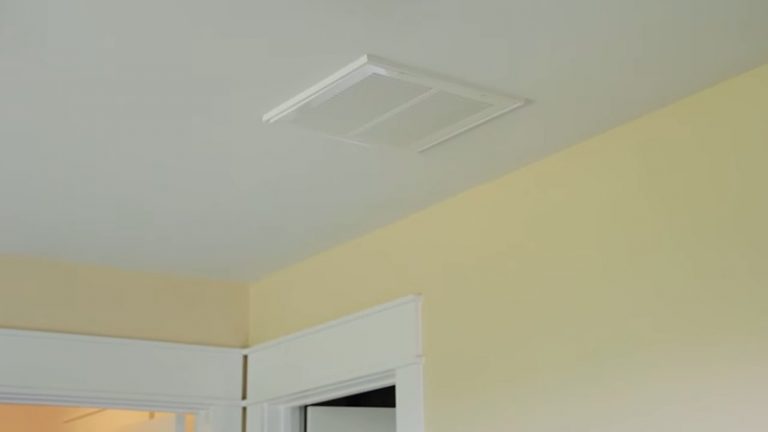Superior Wall Leaking [What to Do?]

Superior walls are precast concrete walls that are used in residential construction as a foundation system. They are made in a factory setting and then transported to the construction site, where they are installed as a complete foundation system. Superior walls are known for their strength, durability, and energy efficiency, and they are often used as an alternative to traditional poured concrete foundations.
You'll Learn About
Superior Walls Leaking
You might have a leak in the wall surrounding your egress door, which is causing water to accumulate behind one of the plates that is used to attach the preformed concrete egress staircase to the superior walls.
It is not advisable to try to fix the leak from the inside of the basement, as this will not address the root cause of the problem. It is also not recommended to use a sealant to try to seal the crevice between the wall and the plate, as this will not be a permanent solution and could potentially cause further damage.
The best course of action would be to address the root cause of the leak by repairing the exterior of the wall. This may involve excavation to access the area where the leak is occurring, and then repairing or sealing the source of the leak.
Depending on the extent of the damage and the cause of the leak, this could involve a variety of repair methods, such as applying a waterproofing membrane, sealing cracks or joints, or replacing damaged sections of the wall.
It is important to properly diagnose the cause of the leak and address it appropriately to prevent further damage to your home. If you are not confident in your ability to do this, it is recommended to hire a professional contractor with experience in repairing leaks in superior walls.
Common Use of Superior Walls in Residential Construction
Superior walls are commonly used in residential construction as a foundation system for new homes, additions, or renovations. They are particularly popular in areas where the soil is unstable or prone to movement, as they provide a stable and consistent foundation.
They are also often used in areas with harsh weather conditions, as they are resistant to damage from frost heave and other types of weather-related damage.
Importance of Addressing Leaks in Superior Walls
It is important to address leaks in superior walls as soon as possible to prevent further damage to the home. Leaks can cause water damage, which can lead to structural issues and costly repairs. Leaks can also create a conducive environment for mold growth, which can pose a serious health hazard.
Ignoring leaks or attempting to patch them up without addressing the root cause of the problem can lead to more serious issues down the road. It is important to properly diagnose the cause of the leak and address it appropriately to prevent further damage to your home.
Causes of Leaks in Superior Walls
Poor Installation Techniques
One of the main causes of leaks in superior walls is poor installation techniques. If the walls are not properly installed, they may not be properly sealed, which can allow water to infiltrate the wall and cause leaks. Poor installation techniques can also lead to cracks or other defects in the walls, which can also lead to leaks.
Damage From Water Infiltration or Frost Heave
Another common cause of leaks in superior walls is damage from water infiltration or frost heave. Water infiltration can occur if the walls are not properly sealed or if there is a problem with the grading or drainage around the foundation. Frost heave occurs when the ground freezes and expands, which can cause the walls to shift and crack, leading to leaks.
Deterioration of Materials Over Time
Over time, the materials used to construct superior walls can deteriorate or degrade, which can lead to leaks. This can be caused by a variety of factors, including exposure to the elements, aging, or chemical reactions. It is important to regularly inspect and maintain superior walls to ensure that they are in good condition and to identify and address any issues before they lead to leaks.
How to Identify a Leak in Superior Walls?
Visual Inspection for Signs of Water Damage or Staining
One way to identify a leak in superior walls is to visually inspect the walls for signs of water damage or staining. This can include looking for stains, discoloration, or other visible signs of water damage on the walls, floor, or ceiling.
It can also be helpful to look for any areas where the wall or floor feels damp or has an unusual musty smell, as these can be indicators of a leak.
Use of Moisture Meters or Other Diagnostic Tools
Another way to identify a leak in superior walls is to use moisture meters or other diagnostic tools. Moisture meters are devices that can be used to measure the moisture content of the walls or other building materials.
By taking readings at various locations on the wall, it is possible to determine if there are any areas with higher than normal moisture levels, which could indicate a leak.
Other diagnostic tools that can be used to identify leaks in superior walls include infrared cameras, which can detect temperature differences that may indicate a leak, and pressure gauges, which can measure the air pressure inside the walls to detect leaks.
Testing for Leaks Using a Water Hose or Other Method
In some cases, it may be necessary to test for leaks using a water hose or other method. This can be done by applying a small amount of water to the exterior of the wall and observing the wall for any signs of leakage.
This method can be particularly useful for identifying leaks that are not visible from the inside of the home. It is important to take care when using a water hose or other method to test for leaks, as applying too much water could cause further damage to the wall.
Repairing Leaks in Superior Walls
Exterior Repairs: Addressing the Root Cause of the Leak From the Outside of the Wall:
To effectively repair a leak in superior walls, it is important to address the root cause of the leak from the outside of the wall. This may involve excavating the area around the wall to access the source of the leak and then repairing or sealing it.
Depending on the cause of the leak, this could involve a variety of repair methods, such as applying a waterproofing membrane, sealing cracks or joints, or replacing damaged sections of the wall.
Interior Repairs: Addressing the Effects of the Leak on the Inside of the Wall:
Once the root cause of the leak has been addressed, it may be necessary to repair any damage that has been caused by the leak on the inside of the wall.
This could involve removing and replacing damaged materials, such as drywall or insulation, and drying out any areas that have been affected by water damage. It may also be necessary to apply a moisture-resistant finish to the walls to prevent future leaks.
Tips for Preventing Future Leaks
To prevent future leaks in superior walls, it is important to ensure that the walls are properly installed and regularly maintained. This may involve following proper installation techniques, such as properly sealing the walls and ensuring that they are properly graded and drained.
It may also involve performing regular maintenance, such as inspecting the walls for cracks or other defects and addressing any issues that are found. By taking these steps, it is possible to extend the lifespan of superior walls and prevent future leaks.
Tips for Addressing Leaks in Superior Walls
Here are a few additional tips for addressing leaks in superior walls:
- Identify the source of the leak: In order to effectively repair a leak in superior walls, it is important to identify the source of the leak. This may involve using a moisture meter or other diagnostic tool to determine the location of the leak, or it may involve performing a water hose test to identify the source of the leak from the outside of the wall.
- Check for plumbing issues: One common cause of leaks in superior walls is a problem with the plumbing. If you suspect that a plumbing issue may be causing the leak, it is important to have a professional plumber inspect the pipes to determine the cause of the problem and make any necessary repairs.
- Inspect the exterior of the wall: Another potential cause of leaks in superior walls is damage to the exterior of the wall. This could be caused by a variety of factors, such as improper grading or drainage around the foundation, or damage from landscaping or construction equipment. It is important to inspect the exterior of the wall for any signs of damage and address any issues that are found.
- Use a dehumidifier: If you have a leak in your superior walls and are unable to repair it immediately, using a dehumidifier can help to reduce the humidity and moisture levels inside your home, which can prevent further damage from occurring.
- Avoid using temporary fixes: While it may be tempting to use a temporary fix, such as patching a hole or applying a sealant, to address a leak in superior walls, these solutions are not permanent and may ultimately cause further damage to the wall. It is important to properly diagnose the cause of the leak and address it appropriately to prevent further damage to your home.
- Seek professional help if necessary: If you are not confident in your ability to repair a leak in superior walls, it is recommended to seek professional help to ensure that the repair is done correctly and safely. A professional contractor will have the knowledge and experience to properly diagnose the cause of the leak and make any necessary repairs.
Frequently Asked Questions
What Are Superior Walls?
Superior walls are precast concrete walls that are used in residential construction as a foundation system. They are made in a factory setting and then transported to the construction site, where they are installed as a complete foundation system.
What Are the Benefits of Using Superior Walls?
Superior walls are known for their strength, durability, and energy efficiency. They provide a stable and consistent foundation and are resistant to damage from frost heave and other types of weather-related damage.
They are also energy efficient, as they have a high insulation value and can help to reduce heating and cooling costs.
How Do I Know if I Have a Leak in My Superior Walls?
There are a few signs to look for that may indicate a leak in superior walls. These can include visible water damage or staining on the walls, floor, or ceiling, areas where the wall or floor feels damp, or an unusual musty smell.
Using moisture meters or other diagnostic tools can also help to identify leaks in superior walls.
How Do I Repair a Leak in My Superior Walls?
To repair a leak in superior walls, it is important to address the root cause of the leak from the outside of the wall. This may involve excavating the area around the wall to access the source of the leak and then repairing or sealing it.
Once the root cause of the leak has been addressed, it may be necessary to repair any damage that has been caused by the leak on the inside of the wall and to take steps to prevent future leaks, such as following proper installation techniques and performing regular maintenance.
If you are not confident in your ability to repair a leak in superior walls, it is recommended to seek professional help to ensure that the repair is done correctly and safely.
Can I Fix a Leak in My Superior Walls From the Inside of My Home?
While it is possible to address the effects of a leak on the inside of your home, it is not advisable to try to fix a leak in superior walls from the inside.
This will not address the root cause of the problem and could potentially cause further damage to the wall. It is important to address the root cause of the leak from the outside of the wall to ensure a permanent repair.
Can I Use a Sealant to Fix a Leak in My Superior Walls?
While it may be tempting to try to use a sealant to fix a leak in superior walls, this is not a permanent solution and could potentially cause further damage to the wall. It is important to properly diagnose the cause of the leak and address it appropriately to prevent further damage to your home.
If you are not confident in your ability to repair a leak in superior walls, it is recommended to seek professional help to ensure that the repair is done correctly and safely.
Final Words
In summary, it is important to address leaks in superior walls as soon as possible to prevent further damage to the home. Leaks can cause water damage, which can lead to structural issues and costly repairs.
They can also create a conducive environment for mold growth, which can pose a serious health hazard. To properly repair a leak in superior walls, it is important to identify the root cause of the leak and address it from the outside of the wall.
This may involve a variety of repair methods, depending on the cause of the leak. It is also important to repair any damage that has been caused by the leak on the inside of the wall and to take steps to prevent future leaks, such as following proper installation techniques and performing regular maintenance.
If you are not confident in your ability to repair a leak in superior walls, it is recommended to seek professional help to ensure that the repair is done correctly and safely.




![R-30 Insulation 2×8 [Everything You Need to Know]](/wp-content/uploads/2023/01/R-30-Insulation-2x8-1-768x432.webp)
